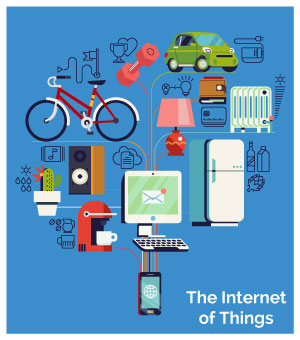The Internet of Things opens up exciting new possibilities…and raises new security alarms.
 The Internet of Things (IoT) has been with us for a while, starting with Internet applications for phones, cars and personal devices. As IoT applications multiply, they are revolutionizing the IT landscape.
The Internet of Things (IoT) has been with us for a while, starting with Internet applications for phones, cars and personal devices. As IoT applications multiply, they are revolutionizing the IT landscape.
Founded on widespread wireless availability, IoT applications consist of several components: sensors, which gather and transmit specific types of data using application software and middleware, and the cloud, which supports communication between devices.
Most of today’s sensors simply gather and transmit data, but emerging versions will handle more complex IoT tasks, leveraging gathered data in increasingly sophisticated ways. For example, factories and delivery methods will be become exponentially more productive and efficient, and transportation systems will become faster, safer and cheaper. The IoT will help us create new technical ecosystems in which we will drive smart cars, work in smart new ways, and live in smart houses, neighborhoods and cities.
As with all breakthroughs, new problems have already arisen, with more on the horizon. On both personal and business levels, issues of privacy and confidentiality have already taken center stage. More ominous still are data-security challenges. What is different is that the more potential entry points a network contains, the greater the risk of penetration by malware. By definition, the IoT will increase those points. In addition, some developers give security short shrift in their rush to get new products to market as quickly and cheaply as possible. These developers are under no legal obligation to build good security into their offerings.
But no matter what the IoT has in store, the data security basics have not changed.
For all its dazzling promise, the IoT is no more nor less than an expansion of the Internet. Although the number of IoT applications is growing, the principles of achieving solid network protection are the same as before. Again, what is different is that the IoT expands the potential entry points for malware attacks. To stay ahead of the expanding opportunities hackers are finding with the IoT, we offer these recommendations.

- Be prepared to reinforce your security program, and let your customers know that you intend to meet IoT-related risks head on. Bring your vendors into your accelerated program immediately, and be aware that your situation relative to the IoT may call for a review of your current vendors.
- As with other security threats, take special care to protect your email.
- Stay informed about how to make web browsing safer for your employees.
- Be aware that IoT applications present easily overlooked opportunities for single points of failure.
- Data security will become even more elaborate than before, so expect the expansion of your data protection to require extra study and effort.
- Review your server recovery plans.
- Stay abreast of trends in malware, such as the recent emergence of Ransomware as a Service (RaaS).
- IoT applications are cloud-driven, so as they become integrated into your IT profile, be sure to reevaluate your cloud backup processes accordingly.
- In the near future, you are likely to need new kinds of tools to deal with threats posed by the IoT. When the time comes to acquire those tools, choose them wisely.
- As threats posed by the IoT emerge and your defenses strengthened, always keep your employees in the loop. Make them full partners in your security defenses.
To learn more about defending against IoT-based security problems, please call us at 1.877.834.3684, or email us at info@renovodata.com.
Please follow our company page on LinkedIn to get the latest information and news on Data Protection and Disaster Recovery.